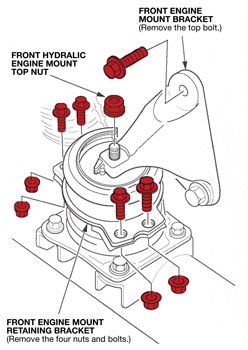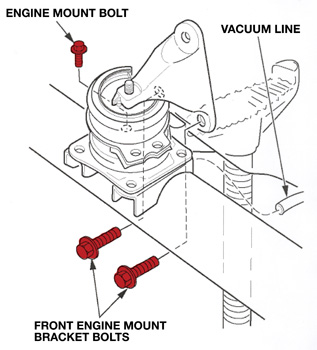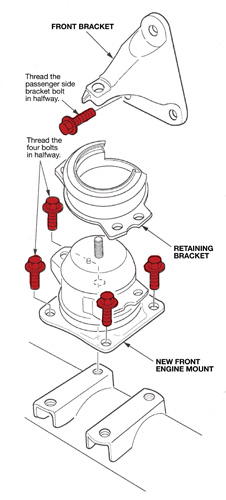Applies To: all 2001-’03 3.2 CL and MDX, 2004 MDX VIN 2HNYD1…4H500001 thru 2HNYD1…4H557556 and all 2000-’03 3.2 TL
If a customer complains of a vibration at idle or harsh engagement when shifting the transmission between Park, Drive and Reverse, the probable cause is the front hydraulic engine mount may have deteriorated and torn.
Diagnosis
1. Bring the engine up to operating temperature, and fully apply the parking brake. 
2. For manual-transmission-equipped vehicles:
Have an assistant stand to the side of the engine compartment to watch the top of the front engine mount. With the engine running at 2,000 rpm, slowly engage the clutch. Your assistant should be looking for contact between the top of the engine mount and the bottom of the engine mount bracket, and listening for noise from that area.
For automatic-transmission-equipped vehicles:
Have an assistant stand to the side of the engine compartment within view of the top of the front engine mount. Shift the transmission to Drive. With your foot firmly on the brake pedal, quickly depress the accelerator pedal and release it. Your assistant should be looking for contact between the top of the engine mount and the bottom of the engine mount bracket, and listening for noise from that area.
3. If there is contact and/or noise, go to Repair Procedure.
Repair Procedure
1. Place the vehicle on a lift, but do not raise it.
2. Remove the top nut from the front hydraulic engine mount. See Figure 1.
3. Remove the top bolt from the front engine mount bracket.
4. Remove the four nuts and bolts that secure the front engine mount retaining bracket.
5. Remove the three accessible bolts holding the engine mount to the subframe.
6. Raise the vehicle. Place a screw jack under the transmission next to the engine and raise the
transmission slightly.
 7. Remove the two remaining front bracket bolts. See Figure 2.
7. Remove the two remaining front bracket bolts. See Figure 2.
8. Disconnect the engine mount vacuum line, and remove the last engine mount bolt.
9. Lower and remove the screw jack, then lower the vehicle.
10. Place a floor jack where the screw jack was, and raise the transmission until the bracket clears the engine mount stud.
11. Remove the front bracket and the engine mount.
12. Remove the four nuts and bolts holding the retaining bracket to the new engine mount, and remove the retaining bracket. See Figure 3.
13. Position the engine mount on the subframe. Install the engine mount bolts loosely.
14. Install the retaining bracket on the engine mount.
15. Install the front bracket and the passenger-side bracket bolt, threading it halfway in.
16. Torque all four engine mount bolts to 34 Nm (25 lb.-ft.).
17. Reconnect the vacuum line.
18. Lower the transmission, and remove the floor jack. Install the four retaining bracket nuts and bolts, and torque them to 22 Nm (16 lb.-ft.).
19. Install the remaining two bolts to the front bracket, and torque them to 38 Nm (28 lb.-ft.).
20. Install and torque the top engine mount nut to 54 Nm (40 lb.-ft.).
Courtesy of Mitchell 1.













